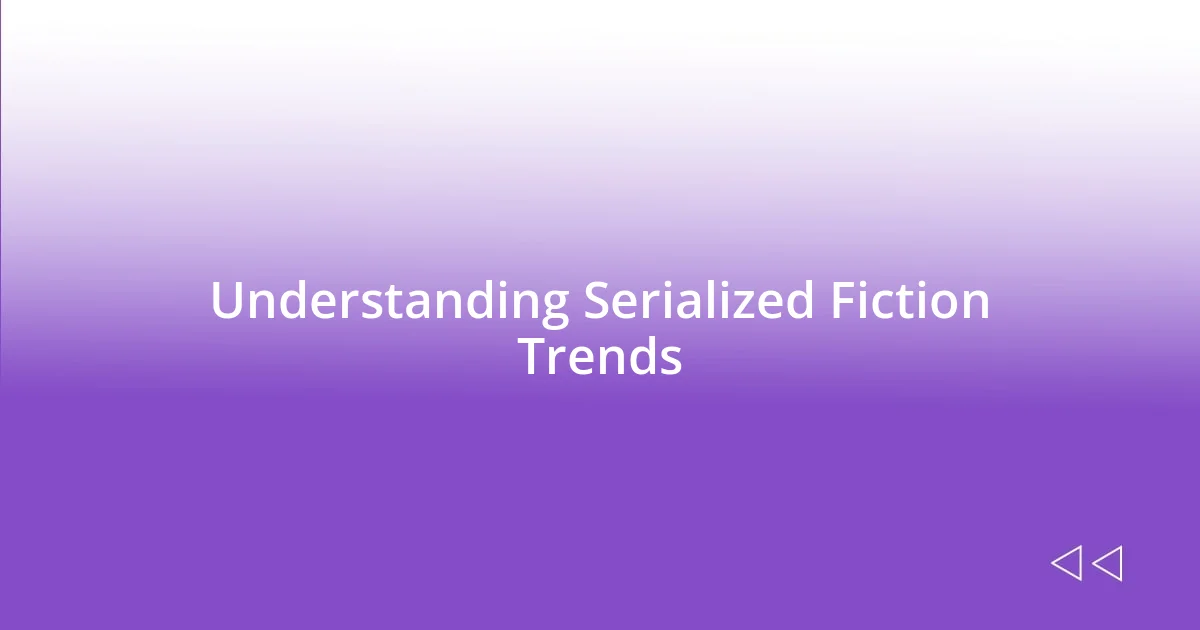Key takeaways:
- Serialized fiction thrives on reader engagement through community interaction, real-time feedback, and diverse genres, enhancing the overall experience.
- Establishing a consistent writing schedule boosts productivity and accountability, while utilizing marketing strategies like social media and newsletters fosters reader loyalty.
- Flexibility in plot development and valuing reader feedback are essential for creativity and improvement, highlighting resilience as a key trait for success in serialized storytelling.

Understanding Serialized Fiction Trends
Serialized fiction has seen a resurgence, particularly online, as readers crave stories they can engage with over time. I can still remember the thrill of waiting for the next chapter of a favorite tale, which made the reading experience feel like a shared journey. How often do we find ourselves dissecting plot twists and speculating on character arcs with fellow fans? This conversational dynamic really elevates the experience.
Another striking trend is the diversity of genres that serialized fiction now encompasses. I’ve come across everything from romance to sci-fi, often intertwined in unexpected ways. This blend allows for greater creativity and resonates with readers looking for fresh narratives. Does that not spark excitement? It’s fascinating to see how various influences inspire authors to push boundaries in ways traditional publishing often does not.
Additionally, the role of technological platforms cannot be overlooked. I recall discovering a platform that not only let me read but also interact with authors and fellow readers. The immediacy of feedback and community connection transformed the way I perceived storytelling. Isn’t it amazing how technology can foster such vibrant literary communities? This shift highlights an evolving relationship between readers and writers that traditional formats may struggle to replicate.

Benefits of Serialized Fiction
Serialized fiction offers several unique benefits that enhance the reading experience. For one, the ongoing anticipation for new chapters creates a sense of excitement that I often find myself relishing. I remember the numerous times I’d refresh my favorite author’s page, almost holding my breath for the next installment, and that adrenaline rush is unlike anything else I’ve encountered in traditional books.
Another significant advantage is the opportunity for reader feedback. I vividly recall when I participated in a discussion thread for a serialized story I adored. The author incorporated some of our suggestions in real-time, which made me feel like I had a stake in the narrative. That direct interaction not only deepened my connection to the story but also highlighted how serialized fiction can foster a more collaborative storytelling process.
Lastly, serialized fiction often tackles complex themes over an extended narrative space. This kind of depth allows authors to develop characters and plots that resonate on multiple levels. One of my personal favorites took its time exploring moral dilemmas, and as the protagonist faced challenges chapter by chapter, I found myself reflecting on my own life choices. It’s this investment in character arcs that often sustains my interest far longer than a standalone novel might.
| Benefit | Description |
|---|---|
| Anticipation | Creates excitement and engagement for readers as they wait for new chapters. |
| Reader Feedback | Allows readers to influence the story’s direction, fostering a sense of community and involvement. |
| Thematic Depth | Enables complex exploration of themes over a longer narrative, allowing for richer character development. |

Choosing the Right Platform
Choosing the right platform for serialized fiction is a pivotal decision that can shape your reading and writing experience. From my journey, I’ve discovered that the best platforms foster community and provide tools for interaction. When I first started, I was drawn to a site that encouraged discussions between readers and authors. The experience was transformative; I wasn’t just a passive reader anymore—I felt like part of something bigger. These connections can elevate your investment in the story, making each chapter feel like a shared achievement.
When selecting a platform, consider these essential factors:
- Community Engagement: Look for platforms that emphasize reader and author interactions. A vibrant community can enhance your experience.
- User-Friendly Interface: A clean, easy-to-navigate design makes reading and accessing new chapters a breeze.
- Genre Variety: Choose platforms that host a wide range of genres. This diversity keeps your reading experience exciting and fresh.
- Feedback Mechanisms: Platforms that allow readers to comment or suggest changes can deepen your connection to the narrative and the author.
- Mobile Accessibility: Having the option to read on the go is vital. Platforms that are mobile-friendly ensure you won’t miss a chapter, no matter where life takes you.
These considerations not only align with your personal preferences but also reflect the aspects that contribute significantly to enjoying serialized fiction online.

Strategies for Engaging Readers
Interacting with readers is key to keeping them engaged in serialized fiction. I remember the thrill of reading chapter notes from an author who shared not just plot developments but also personal snippets about their writing process. It felt like inviting the readers into the author’s world. Engaging with readers in this way can spark excitement and create a layer of intimacy that brings the story to life in a way that plain text often can’t. Don’t you think that behind-the-scenes insights can deepen a reader’s appreciation for a story?
Additionally, cliffhangers have an undeniable power. When I read a story that ended a chapter on a shocking twist, I found myself literally gasping. That suspense not only made me eager for the next installment but also lingered in my thoughts long after I closed the page. Crafting well-timed cliffhangers can transform a good story into an unforgettable experience, compelling readers to center their lives around your narrative.
Moreover, establishing a consistent release schedule can be a game changer for maintaining reader interest. I’ve seen authors who set specific days for new chapters, and it’s amazing how the anticipation builds. I’d find myself counting down the days as if it were a special event. Readers appreciate predictability, which can foster a sense of commitment and community. Isn’t it fulfilling to know that you’re part of something that resonates with a larger audience?

Building a Consistent Writing Schedule
Building a consistent writing schedule has been a vital piece of my writing journey. When I first started publishing serialized fiction, I was overwhelmed by the temptation to write whenever inspiration struck. However, I quickly realized that setting specific days and times made a world of difference. For example, dedicating Saturday mornings to writing helped me not only make tangible progress but also allowed my mind to immerse itself in the story as if it were a ritual. Does having that structure empower you, too?
I’ve also discovered that accountability can be incredibly motivating. By sharing my schedule with fellow authors or readers, I could feel a kind of collective energy pushing me forward. When readers knew to expect my updates every two weeks, that anticipation created a gentle pressure to stay on track. Believe me, there’s nothing quite like the thrill of receiving messages from excited fans asking for the next installment. Have you ever felt that buzz of expectation? It can really fuel your creativity!
One of the most impactful changes I made was to incorporate short, focused writing sessions into my routine. I found that writing in bursts of 30 to 45 minutes led to higher productivity and clearer thoughts. It’s almost like a workout for your creativity. I would set a timer, eliminate distractions, and dive deep into my narrative. The thrill of that focused intensity often led to unexpected breakthroughs in my story. Have you tried this approach? It might just unlock new levels of inspiration for you!

Marketing Your Serialized Work
Marketing your serialized work can feel like navigating a maze, but I’ve found that building a strong online presence is essential. When I first started sharing my stories, I created social media accounts dedicated to my writing. It opened doors to not just sharing updates but also connecting with potential readers. Have you ever considered how much personal interaction can enhance your marketing efforts? Engaging with your audience through posts, polls, and sneak peeks creates a warm, inviting atmosphere that nurtures loyalty.
I also recommend leveraging writing communities and platforms where serialized fiction thrives. I vividly remember joining a dedicated forum where fellow authors banded together to promote each other’s works. It wasn’t just about self-promotion; it was exciting to see how collaboration could amplify our reach. Have you participated in these spaces? They can turn into valuable networks where support is reciprocated, enhancing visibility not just for your work but for others as well.
Don’t underestimate the power of email newsletters, either. Early on, I hesitated to dive in because I thought my updates might bore my readers. But once I started sharing behind-the-scenes thoughts, exclusive excerpts, and upcoming chapter announcements, the response was incredible. It felt intimate, almost like chatting with a friend. Just imagine how your stories can resonate with readers when you share your journey with them! Have you thought about what unique insights you could offer? Crafting newsletters can significantly deepen reader engagement and keep your audience eagerly awaiting each installment.

Lessons Learned from My Journey
I’ve learned that flexibility is crucial in the world of serialized fiction. Early on, I rigidly clung to my original plot, which stifled my creativity. It wasn’t until I allowed myself to pivot when needed that my writing truly flourished. One time, a subplot unexpectedly gained traction, and following that lead led to a twist that captivated my readers. Have you allowed yourself that kind of freedom? Sometimes, the best stories unfold when we embrace the unexpected.
Another valuable lesson I’ve picked up is the importance of reader feedback. Initially, I was hesitant to share drafts, fearing criticism. However, I found that constructive input not only refined my work but also created a sense of community. I remember a reader pointing out how a character’s dialogue felt disconnected, which prompted me to dig deeper into their motivations. It was a game changer. How do you think your writing could evolve with the insight from your audience?
Lastly, I can’t emphasize enough how crucial resilience has been throughout my journey. There were days when the words didn’t flow, and it felt easier to give up. But every time I pushed through those tough moments, I emerged stronger. I recall a particularly challenging weekend when I wrote just a few sentences, but it led to a breakthrough days later. Isn’t it remarkable how persistence can turn a frustrating day into a stepping stone for success? Embracing the process, with its ups and downs, has been one of the most rewarding lessons I’ve learned.














